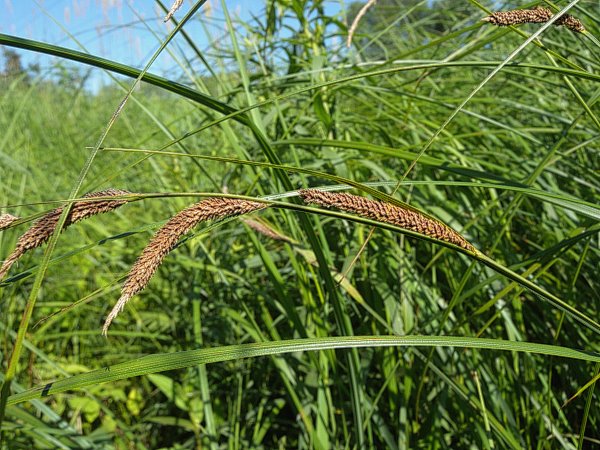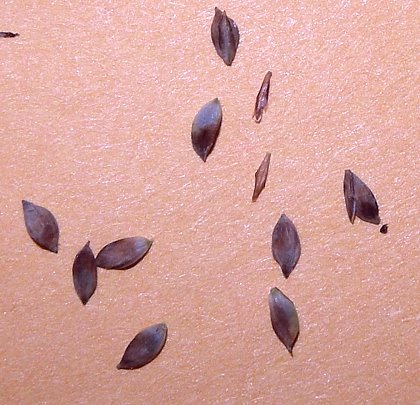
Each fertile culm terminates in an inflorescence up to 1' long that consists of 1-3 staminate spikelets, 2-4 pistillate spikelets, and leafy bracts. Some spikelets may have staminate florets above and pistillate florets below. All spikelets are straight or slightly nodding, and staminate spikelets are located above the pistillate spikelets. The pistillate spikelets are ¾-3" long and narrowly cylindrical in shape (about 5 mm. across); they are densely covered with perigynia that are overlapping and ascending. The staminate spikelets are ½-2½" long and even more narrow than the pistillate spikelets. The terminal staminate spikelet develops on a peduncle about ½-1" long, while the remaining spikelets are sessile or nearly so. Immature spikelets are green, but they turn brown at maturity. The perigynia are 2.5-3.0 mm. in length, broadly ovoid-ellipsoid in shape, somewhat flattened, and hairless. Both their inner and outer sides are essentially nerveless, although their outer sides may have very faint longitudinal veins that are difficult to see. The pistillate scales are 1.5-3.0 mm. in length, oblong or oblong-lanceolate in shape, and hairless, tapering to blunt tips. They are also green-veined along their midsections and membranous along their margins. Underneath the pistillate spikelets, there are leafy bracts up to 5" long and 4 mm. across, becoming smaller as they ascend the inflorescence. The
Cultivation: The preference is full sun, wet to moist conditions, and soil that is sandy or mucky. This sedge adapts readily to shallow seasonal flooding, forming tussocks above the water-line. This increases the supply of oxygen to the roots. In some situations, this sedge can spread aggressively.
Range & Habitat: The native Tussock Sedge is locally common in northern Illinois, occasional in central Illinois, and rare to absent in the southern section of the state. Habitats include sedge meadows, fens, seeps, low areas along springs, prairie swales, and seasonal wetlands. In these habitats, Tussock Sedge is not uncommonly the dominant plant. It adapts to both sandy and non-sandy wetlands.
Faunal Associations: The following leaf beetles have been observed to feed on Tussock Sedge: Donacia bimpressa, Plateumaris frosti, Plateumaris metallica, Plateumaris nitida, Plateumaris pusilla, and Stenispa metallica. The caterpillars of several skippers feed on this and other sedges (Carex spp.): Euphyes conspicuus (Black Dash), Euphyes dion (Dion Skipper), Euphyes vestris (Dun Skipper), Poanes massoit (Mulberry Wing), and Poanes viator (Broad-Winged Skipper). Other insect feeders include Sphenophorus costicollis (Sedge Billbug), the seed bugs Cymus angustatus and Oedancala dorsalis, the plant bugs Mimoceps insignis and Teratocoris discolor, stem-boring larvae of the flies Cordilura varipes and Loxocera cylindrica (Rust Fly), caterpillars of the butterflies Satyrodes appalachia (Appalachian Brown) and Satyrodes eurydice (Eyed Brown), caterpillars of the moths Macrochilo absorptalis (Slant-Lined Owlet) and Chortodes inquinata (Tufted Sedge Moth), several species of leafhoppers (primarily Cosmotettix spp.), and sedge grasshoppers (Stethophyma spp.). The seeds and spikelets of wetland sedges are an important source of food to many ducks, rails, and other wetland birds (see Bird Table). To a limited extent, Muskrats feed on the roots, sprouts, and culms of these plants. There are also records of such turtles as Chelydra serpentina (Snapping Turtle) and Kinosternum subrubrum (Eastern Mud Turtle) feeding on the spikelets and possibly other parts of sedges. Because Tussock Sedge often forms dense colonies of tall plants, it provides excellent cover for the Sedge Wren and other kinds of wildlife.

Photographic Location: A sandy swale at the Indiana Dunes National Lakeshore in NW Indiana. In one of the photographs, the perigynia and pistillate scales have turned black because of an extended period of cool moist storage.
Comments: Many people are unaware that Carex stricta (Tussock Sedge) is just one of a small group of large tussock-forming sedges that have long whip-like leaves and inflorescences with multiple pistillate and staminate spikelets that are narrowly cylindrical. Three other species in this group can be found in Illinois that are difficult to distinguish from Tussock Sedge. The first species, Carex aquatilis substricta (Aquatic Sedge), differs from Tussock Sedge by having wider leaf blades (often exceeding 6.5 mm. across) and perigynia that are more obovoid in shape (widest above the middle). The lowest leaves of this species also have well-developed blades. The second species, Carex emoryi (Emory's Sedge), differs from Tussock Sedge by having perigynia with 3-5 conspicuous veins along their outer surfaces and its achenes are more oblongoid in shape. In addition, some of the longer leaf blades of this species often overtop its culms. The third species, Carex haydeni (Hayden's Sedge), differs from Tussock Sedge by having pistillate scales that are longer than the perigynia and its perigynia are more orbicular in shape. Its pistillate scales also have more pointed tips than those of Tussock Sedge.